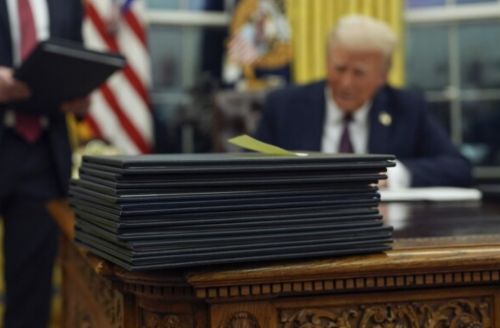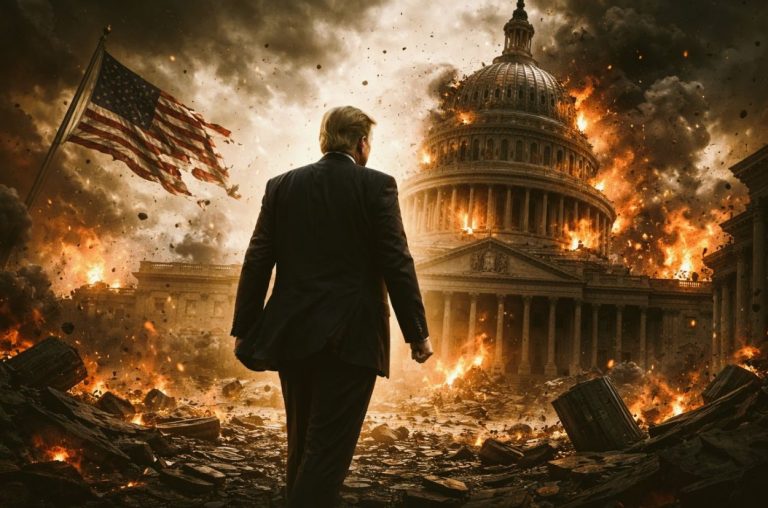

By declaring emergencies at a record pace and sending National Guard units into multiple U.S. cities, he has tested the resilience of laws designed to limit executive overreach.

By Matthew A. McIntosh
Public Historian
Brewminate
Introduction
The announcement came on a Saturday morning, delivered in the blunt cadence that has become Donald Trump’s political signature: federal troops would be sent to Portland, Oregon, to “protect ICE facilities” and authorized to use “full force, if necessary”. For many, it was a chilling echo of earlier deployments, to Los Angeles and Washington, D.C., where National Guard units were dispatched under the banner of emergency declarations. Now, with Portland labeled “war-ravaged” and federal buildings said to be under “siege,” the second Trump administration is advancing an unprecedented campaign of domestic troop mobilizations. Supporters frame them as acts of “law and order,” but critics see something darker: the normalization of emergency powers once reserved for extraordinary crises, now wielded at a frequency unmatched by any previous president.
Background: National Emergencies and Executive Power
When Congress passed the National Emergencies Act in 1976, the intention was to rein in a presidency that had invoked emergency powers with little oversight. The law required presidents to formally declare emergencies, specify which statutory powers they were activating, and submit to regular congressional review. In practice, however, once declared, emergencies have proven difficult to terminate: only a handful have ever been revoked by Congress, and most linger for years beyond their initial justification.
Even so, no modern president has wielded the statute with the speed and breadth of Donald Trump’s second term. Within just a few months of returning to office, Trump had proclaimed more national emergencies than any of his predecessors in comparable timeframes. Some were revivals of familiar themes, such as the southern border emergency he first declared in 2019, while others targeted issues ranging from crime surges in Washington, D.C., to trade disputes and regulatory rollbacks.
Historians and legal scholars note that while presidents before him occasionally relied on emergency declarations to secure additional powers, Trump has made them a central governing tool. The acceleration, critics argue, risks eroding the distinction between genuine crises and political expediency, turning what was designed as an extraordinary measure into a standing feature of executive authority.
Deployments of Troops and the National Guard to U.S. Cities
Overview
Trump’s reliance on emergency powers has been matched by his willingness to send uniformed forces into American cities, something presidents have historically done sparingly and only under extreme conditions.
Washington, D.C.
In August, Trump declared a “crime emergency” in the District of Columbia, invoking his authority under the D.C. Home Rule Act to take control of the Metropolitan Police Department and place it under federal command. The order was extraordinary not only for its scope but also for its timing: crime in Washington was already at its lowest level in three decades. Critics accused the president of manufacturing a crisis to justify expanding federal control.
Los Angeles
Earlier in September, National Guard troops appeared on the streets of Los Angeles after protests outside ICE facilities. A federal judge ruled the deployment illegal under the Posse Comitatus Act, which bars active-duty forces from domestic law enforcement. Yet the legal battle was far from over: an appeals court upheld Trump’s authority to deploy guard units, citing federal prerogatives in protecting national security facilities. The dueling rulings underscored the unsettled constitutional terrain his actions have opened.
Portland
The most recent flashpoint is Portland, Oregon. On September 27, Trump announced that troops would be sent to “protect ICE facilities” in the city and authorized to use “full force, if necessary”. He described Portland as “war-ravaged” and federal buildings as under “siege.” Oregon Governor Tina Kotek and Portland’s mayor condemned the move, calling it an uninvited intrusion into local affairs.
Together, these deployments mark an expansion of presidential willingness to override state and local autonomy in favor of federal muscle. Where past presidents treated domestic troop mobilization as a last resort, Trump has begun to normalize it as a first response.
Legal and Constitutional Questions
Trump’s repeated deployments have sharpened longstanding debates over the limits of federal power in domestic law enforcement. Central to those debates is the Posse Comitatus Act of 1878, which prohibits the use of federal troops for civilian policing unless explicitly authorized by Congress. National Guard units can be deployed under federal control, but their use in protest management and city policing has raised alarms about blurred boundaries between civil and military authority.
In Los Angeles, a federal judge ruled that Trump’s deployment violated the Posse Comitatus Act. The ruling was celebrated by civil liberties advocates but was swiftly complicated when an appeals court sided with the administration, holding that Trump’s order fell within his constitutional powers to defend federal installations.
The District of Columbia case posed a different set of issues. Trump’s emergency declaration there allowed him to federalize the Metropolitan Police Department, citing authority under the D.C. Home Rule Act. Legal experts questioned whether the move was proportional, given that D.C.’s crime rate was already declining, and warned that it could set a precedent for federal intervention in local law enforcement on political grounds.
Underlying all of these actions is a tension between federal and state sovereignty. Governors, like Oregon’s Kotek, have protested unrequested troop deployments, calling them unconstitutional intrusions into state authority. Yet Trump’s defenders argue that protecting federal buildings and personnel is a legitimate exercise of presidential power, regardless of local objections.
Congressional oversight, envisioned as the primary check under the National Emergencies Act, has so far proven ineffective. While lawmakers can vote to terminate an emergency, such a resolution requires supermajorities to overcome a presidential veto. As a result, Trump’s declarations remain largely intact unless challenged in court.
With conflicting lower court rulings and multiple legal challenges already underway, many observers expect the Supreme Court will eventually be forced to clarify just how far a president can go in deploying military forces on American soil.
Comparisons and Historical Context
Domestic use of troops has a long but fraught history in the United States. Past presidents have occasionally invoked emergency powers to deploy forces—Dwight Eisenhower to enforce desegregation in Little Rock, Lyndon Johnson during the 1967 Detroit uprising, George H.W. Bush to restore order in Los Angeles after the Rodney King verdict. But these moments were tied to extraordinary crises of violence or constitutional enforcement, not routine governance.
What sets Trump apart, analysts note, is both the scale and tempo of his actions. NPR reported in June that Trump is declaring emergencies faster than any other president in U.S. history. Within months of his second inauguration, he had already surpassed the pace of his predecessors, treating emergency powers less as rare exceptions and more as tools of day-to-day governance.
This acceleration has drawn warnings from legal scholars who see echoes in global history, where authoritarian regimes consolidated power by normalizing emergency decrees. The Supreme Court is now being asked to weigh in on whether Trump’s pattern “strains constitutional boundaries and threatens democratic guardrails.”
The Portland deployment crystallizes those fears. While Trump described the city as “war-ravaged” and under “siege,” local officials rejected that characterization, underscoring the gap between the White House’s rhetoric and conditions on the ground. The reliance on militarized language, paired with a growing list of emergency orders, suggests a deliberate attempt to recast domestic politics in terms of perpetual crisis, an approach that, historically, has undermined checks and balances.
Reactions and Political Dynamics
State and Local Leaders
Governor Kotek and Portland’s mayor condemned Trump’s troop order as an “unrequested” and “unwarranted” intrusion into state sovereignty, Reuters reported. In Los Angeles, Governor Gavin Newsom attempted to recall the Guard, only to be blocked in federal court, highlighting the limits of state resistance once federal authority is invoked.
Congress and Civil Liberties Advocates
On Capitol Hill, Democrats have decried the flood of emergency declarations as an abuse of the National Emergencies Act, warning that Trump is eroding the line between executive authority and congressional oversight. Civil liberties groups have echoed those concerns, pointing to the Los Angeles ruling that found the Guard deployment illegal under the Posse Comitatus Act as evidence that Trump is straining constitutional limits.
The Administration’s Defense
Trump and his allies frame the deployments as necessary measures to defend federal personnel and property. Announcing the Portland action, Trump said ICE facilities were “under siege” and portrayed the city as “war-ravaged.” Supporters argue that the president not only has the right but the obligation to act when local authorities fail to protect federal installations.
Public Opinion and Media Commentary
Media outlets have noted the partisan divide: Trump’s base views the troop deployments as a strong stance on “law and order,” while opponents see them as creeping authoritarianism.
Risks, Trajectories, and What to Watch
With multiple lawsuits underway, the courts are likely to play the most immediate role in determining the scope of Trump’s emergency powers. The clash between the Los Angeles district court’s ruling and the appeals court’s contrary decision all but guarantees eventual Supreme Court review.
Congress also has the theoretical power to terminate emergencies, but the National Emergencies Act makes doing so politically difficult: resolutions can be vetoed by the president, requiring supermajorities in both chambers to override. Given the current partisan divide, meaningful legislative pushback appears unlikely.
Observers are now watching whether Trump extends this model to other cities. Having already targeted Washington, Los Angeles, and Portland, he has hinted at deployments in other urban centers facing protests or federal facility disruptions. Each new invocation risks deepening the perception that the United States is governed in a state of rolling emergency, an environment in which normal political debate is supplanted by executive fiat.
The broader risk is structural. If frequent emergencies and domestic troop deployments become normalized, future presidents may inherit a vastly expanded precedent for unilateral action. What began as a tool for rare crises could become, in effect, a standing grant of extraordinary power.
Conclusion
Donald Trump’s second term has already redrawn the boundaries of presidential authority. By declaring emergencies at a record pace and sending National Guard units into multiple U.S. cities, he has tested the resilience of laws designed to limit executive overreach. Supporters frame these moves as necessary defenses of law and order, while opponents warn they mark a dangerous slide toward authoritarian rule.
The constitutional questions now swirling, from the meaning of the Posse Comitatus Act to the limits of the National Emergencies Act, are not abstract. They strike at the heart of the balance between executive power, state sovereignty, and the rights of American citizens. Whether the courts, Congress, or the electorate can restore those guardrails may determine not only the trajectory of Trump’s presidency but the long-term health of American democracy.
Originally published by Brewminate, 09.29.2025, under the terms of a Creative Commons Attribution-NonCommercial-NoDerivatives 4.0 International license.


